Pincer Grasp: When Can My Baby Pick Up Smaller Pieces of Food? with Rachel Harrington, COTA/L, AC
In this episode we're talking about:
- What the pincer grasp is and when babies develop it
- Developmental activities you can engage your baby in
- Why we wait until babies have their pincer to cut food smaller
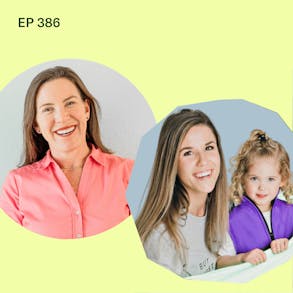
LISTEN TO THIS EPISODE
Episode Description
When can I start cutting up my baby’s food into smaller pieces? Your baby needs their pincer grasp to pick up smaller pieces of food to self-feed…and for most babies, they won’t develop this skill until 9 or 10 months of age. In this episode Rachel Harrington, COTA/L, AC shared some insight on how babies develop their pincer grasp and what you can do to help along the way.
About the Guest

- Rachel Harrington is a pediatric occupational therapy assistant and mom of 3
- She is passionate about sensory integration, primitive reflexes and early intervention.
- Rachel hosts the All Things Sensory podcast & runs the Instagram @thesensoryproject208

Links from this Episode
- Follow Rachel on Instagram @thesensoryproject208
- All Things Sensory podcast https://harkla.co/blogs/podcast
- Rachel’s Primitive Reflexes course
- Baby-Led Weaning with Katie Ferraro program with the 100 First Foods™ Daily Meal Plan, join here: https://babyledweaning.co/program
- Baby-Led Weaning for Beginners free online workshop with 100 First Foods™ list to all attendees, register here: https://babyledweaning.co/baby-led-weaning-for-beginners
Other episodes related to this topic:

Latest Episodes
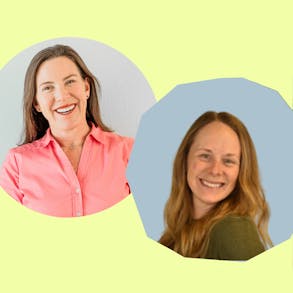
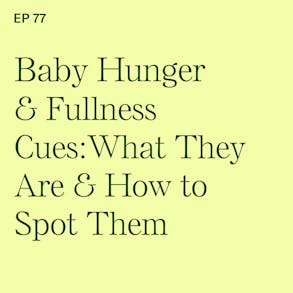
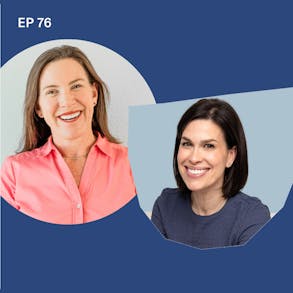
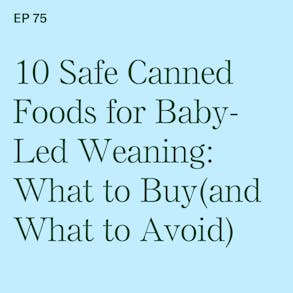
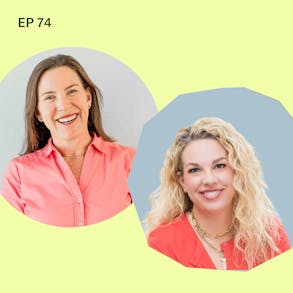
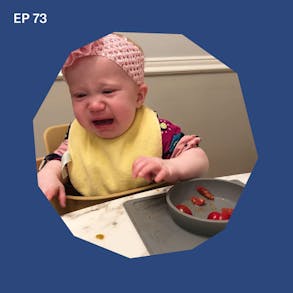
Katie Ferraro (0s):
It's Thanksgiving week. I know personally as somebody who cooks for babies for work and then has to cook for 10 people in my own house after work, I have much more stamina in the kitchen. If someone tells me exactly what to prepare, I love nothing more than someone's like, can you please bring this dish to the party? Or a kid will say, mom, will you make this exact thing for dinner? Because I don't mind cooking. I just don't like picking out which foods we're gonna eat. And when it comes to feeding your baby, if you are feeling stuck about which foods to offer, for baby-led weaning, maybe you're feeling stuck and like I'm just offering the same simple starter foods. It's avocado, banana, and sweet potato every week. Then I have just the solution for you, and that is to follow my five step feeding framework. The five step feeding framework is my exact sequence of foods that you offer your baby each week so you can safely introduce your baby to five new foods every week.
Katie Ferraro (42s):
I'll teach you all about how to make this happen in your own household inside of my free online workshop called Baby-Led Weaning For Beginners. I just redid the whole Baby-Led Weaning For Beginners Workshop. There are so many good videos and visuals of how to prepare food safely, ideas on what to feed for the first few weeks, plus a whole section on making allergenic foods and meats safe for your baby to eat. Everybody on the free Baby-Led Weaning For Beginners Workshop gets a copy of my original 100 First Foods list because I never want you to run out of ideas of foods your baby can eat. You can sign up for this workshop at babyledweaning.co/workshop. You can register it and take it right now like if you need a break from your family, you can do it later today when your baby is napping or sleeping.
Katie Ferraro (1m 23s):
Or you can take it tomorrow if you've got some time to learn about baby-led weaning. Again, that signup is at babyledweaning.co/workshop and I'd love to see you there. There are so many things that I have held off on buying for the past few months and like I want this or I need this right now. No, I'm gonna hold off 'cause I know it's gonna go on big time Black Friday sale. So on my list of stuff to buy myself on Black Friday are more ezpz lids for my Mini mats and my Mini bowls. So I've been making all of my friend Baby Ezra his 100 First Foods and then I deliver the five new foods and meals to their house each week for the baby. But I don't have enough lids to make up each of the weekly plates and I refuse to pay full price. So right now ezpz is having a 30% off sale.
Katie Ferraro (2m 3s):
All of the feeding gear, including the ezpz lids, are 30% off with the affiliate discount code BLWHOLIDAY23. And this sale runs now through November 27th. It's valid for us purchases only ezpzfun.com. Again, that 30% off sale code BLWHOLIDAY23 if you want to stock up on feeding gear too, this is also a really good time, like 30% off is the steepest ezpz discount you will ever see my regular code KATIE10 is only good for 10% off. So the bump to 30% is nice if you've got baby showers or new baby gifts that you gotta buy. I love the ezpz First Foods set. Or if your own baby is turning one or you have one year old parties to attend any time in the new year.
Katie Ferraro (2m 48s):
The Mini feeding set from ezpz at 30% off is a steal for the one year olds. Again, that ezpz affiliate discount code is BLWHOLIDAY23 now through November 27th, happy feeding.
Rachel Harrington (3m 6s):
In the sensory integration realm, we have receptors, we have tactile processing receptors all over our body, but in our mouth as well. And my rule of thumb is a kiddo is not going to be able to tolerate different food textures in their mouth if they're not able to tolerate those different textures in their hands and on their skin first.
Katie Ferraro (3m 26s):
Hey there. I'm Katie Ferraro, Registered Dietitian, college nutrition professor, and mom of seven specializing in baby-led weaning here on the Baby-Led Weaning Made Easy podcast. I help you strip out all of the noise and nonsense about feeding, leading you with the confidence and knowledge you need to give your baby a safe start to solid foods using baby-led weaning. When you were first learning about how babies eat food, did you think that you should cut the foods up really small because it would be safer for them to eat? I did that as a first time mom. I was like, I don't want 'em to choke on these big pieces of food. But it turns out the smaller pieces of food are actually not ideal for early eaters so we spend a lot of time on the podcast talking about how babies learn to chew and swallow and interviewing different experts.
Katie Ferraro (4m 16s):
But another reason why we don't offer the small pieces of food aside from the fact that they can be a choking hazard from early eaters is because they can't pick up those small pieces of food if they don't yet have their pincer grasp. So my guest today is here to talk all about the pincer grasp and when can my baby pick up smaller pieces of food. So my guest's name is Rachel Harrington. She is an occupational therapy assistant and she specializes in sensory integration, primitive reflexes, and early intervention. She's the podcast host for a show called All Things Sensory. She shares a lot of simple sensory strategies. She does a lot of work on Instagram at the sensory Project 208.
Katie Ferraro (4m 57s):
And today Rachel's here to teach us a little bit about these different primitive reflexes. So I wanted to call the episode the Pincer Grasp one 'cause I want you to click in and listen 'cause I know you know what the pincer grasp is, but I know you also have questions about, okay, well then when can they start picking up smaller pieces of food? And in our program we teach that after your baby has been experimenting with foods generally for about eight weeks. So if you started it at six months of age by about the eight month mark is when we start introducing combination and multi textured foods. And then somewhere between the 9 and 11 month mark, that's when your baby's going to start developing their pincer grasp. So if they have that combination of the ability to handle combination textured foods and they're able to use their pincer grasp too, that's an indicator that it's time and it's okay to make the switch to smaller pieced foods.
Katie Ferraro (5m 44s):
We don't offer smaller pieced foods to early eaters or certainly older babies if they've never had anything in their mouth except a puree or a thickened liquid like breast milk or formula. We don't move to smaller pieces of food that early. So we're gonna have a conversation in this episode about the pincer grasp and how it develops. And with no further ado, here is Rachel Harrington teaching about the pincer grasp and when can my baby pick up smaller pieces of food.
Rachel Harrington (6m 9s):
Thanks for having me.
Katie Ferraro (6m 10s):
So. I love your Instagram account, the Sensory Project 208. I'd love to hear a little bit of your background, what you do professionally, and then also I'm just been curious like what's the significance of the number 208?
Rachel Harrington (6m 21s):
So professionally, I'm a certified occupational therapy assistant. I specialize in sensory integration, early intervention, primitive reflex integration. I am a mom of two. I have a three-year-old on Friday. And then I have a 15 month old little girl who I did all the baby-led weaning with, and yeah it's a crazy season right now to say the least. I run two businesses and then I work part-time for another company for our podcast and stuff. And then I just do education right now, sensory education. I'm not in the clinic right now anymore, just 'cause once I had Tripp I realized there's just not time right now.
Rachel Harrington (7m 2s):
So I do miss that. But I'm excited to just be able to teach and be home with my kids and, and do all the things. So the 208, the story behind the 208, it's really exciting. I live in Idaho and that is the, that's the area code is 208 and and when I made my Instagram like I don't know, six years ago, you know, it wasn't how it is now and so I just the sensory project was taken. So I was like, oh well I'll just do sensory project 208.
Katie Ferraro (7m 31s):
I like it. It's a little bit of intrigue.
Rachel Harrington (7m 35s):
Yeah.
Katie Ferraro (7m 35s):
Alright. What's the story with your podcast, All Things Sensory? I know you share simple sensory strategies and tips. Is it for all ages, babies, who's your target audience there?
Rachel Harrington (7m 46s):
Yes, we have been podcasting for five years now. And it is, it's for everyone. It's for parents, it's for therapists, it's for educators. It's just sensory made simple and we just wanna make sure that everyone is realizing that we all have sensory systems, we all need input in some way. Some of us need more input, some of us need less input. And it's just an amazing avenue for free information just like your podcast.
Katie Ferraro (8m 12s):
So as a pediatric occupational therapy assistant, I know you always say you're passionate about sensory integration, primitive reflexes, and earlier intervention, and I wanted to know if you could share a bit about what each of those three terms mean to you and then how did you come to specialize in this area?
Rachel Harrington (8m 27s):
Yeah, so the first thing is sensory integration. It really just comprises everyone's way of processing the world around them. So, we all have eight senses, believe it or not. We've got our typical five and then we have our three hidden senses, which I think are some of the most impactful. We have our vestibular system, which is our sense of movement and it's recognizes our head position changes. We have our sense of proprioception, which is my favorite. It's really the all grounding sense and it helps us recognize where we are in space. I always say, but first heavy work. And then we have our interoceptive system, which really connects to that emotional regulation and internal senses of, am I hungry? Am I thirsty? Do I need to go to the bathroom? Am I hot, am I cold?
Rachel Harrington (9m 8s):
And everything, everything with what's going on inside of our body. So that's really what sensory integration is. We can be over-responsive so we can be sensitive to sensory input, we can be sensory seeking and we can be craving some sensory input and we need more sensory input, and then we can be kind of under-responsive and need more but not really know how to get it. So that's kind of sensory integration in a nutshell. Primitive reflex integration is also something that I am so passionate about. I just got certified as a the primitive reflex specialist, which is exciting. And really reflex integration comes down to things like the moral reflex, that startle reflex, the palmer grasp, the rooting reflex, all of those reflexes that we're born with and they help babies.
Rachel Harrington (9m 50s):
They keep us alive, they keep us safe. But the trick is they need to go away and integrate and mature into those higher level motor patterns and cognitive patterns. For some reason, they get stuck in our body in certain cases and they need help to integrate. And when they get stuck, they can cause a variety of symptoms like anywhere from anxiety and nervousness to balancing coordination challenges and you know, difficulty with feeding and swallowing and, and really a whole host of coordination challenges. And so that's really reflexes in a nutshell. Lots of nutshells going on right now. And then early intervention is really just that birth to three age.
Rachel Harrington (10m 30s):
And I didn't really come to be so passionate about it until I had my own kiddos and I realized just how important it is to target the sensory system early, provide novel, new sensory experiences for these babies to have to work through and process. And if there is an issue, instead of waiting and seeing what's gonna happen, just getting into therapy, getting some resources, getting some tips, the sooner the better.
Katie Ferraro (13m 15s):
So with the primitive reflex specialist, and you said you just got certified in this and you mentioned some of the different reflexes, are there certain conditions where children or babies with, they're diagnosed with it that they tend to have more issues with these primitive reflexes? Like are there any typical disease states that you see on your caseload?
Rachel Harrington (13m 34s):
Yeah, it honestly, if a child has a diagnosis of honestly anything, you know, autism, ADHD, developmental delays, down syndrome, cerebral palsy, really any diagnosis, you're gonna have a higher chance of having these retained reflexes. But the research is showing that typical kids, quote unquote typical kids are having retained reflexes and they're going into preschools and they're testing them and you know, upwards of 75% are having at least one retained reflex. So it's really common, but it's just not being addressed. And so that's where I think it's important to get that education out there.
Katie Ferraro (14m 9s):
So what would be an example of a retained reflex that a preschooler might have?
Rachel Harrington (14m 13s):
So a big one. My son just started preschool today and so it's stuck in my head, but the moral reflex. So a moral reflex is your startle reflex. It makes us protect our body and it helps us clinging to mom and just alert the caregiver that we're in stress and it releases that cortisol, that fight, flight or freeze response. So if it doesn't integrate the, like a toddler in preschool or an older child can be chronically anxious, they can struggle with sensory processing, they can be sensitive to lights and sounds. They can have allergies actually because there is so much cortisol being released into their body all the time. So that's a common one that most people know about that that startle reflex.
Rachel Harrington (14m 57s):
And you know, anytime a child is like laying on their back and they're really hesitant and they're uncomfortable when their feet leave the ground on the playground, that can be a sign that moral reflexes is lingering
Katie Ferraro (15m 7s):
And then there's therapy that can then help them. What was the term you used? Not get rid of it, but...
Rachel Harrington (15m 13s):
Yeah, integrate.
Katie Ferraro (15m 13s):
Yep, integrate it. That's so much nicer than get rid of!
Rachel Harrington (15m 18s):
More, make it more mature. You know, OT is a great resource. We have a course that teaches testing and integration as well, which we can talk about later on. But you know, usually we don't address these reflexes and we can't really work on a true integration program until they're a little bit older, like four or five years old. So, we just like to do typical movement activities for these younger kids, getting them outside and playing and climbing trees, you know, what we should be doing.
Katie Ferraro (15m 41s):
So our listeners are parents and caregivers of babies, primarily 6 to 12 months of age who are just starting that transition to solid foods. So for the babies who are just approaching the six-month mark and the parents who are listening and before they start solid foods, can you give us some of examples of what you would be looking for a baby this age to be able to do? Like if you were doing an assessment?
Rachel Harrington (16m 1s):
Yes. So first thing, I don't, I don't do the assessing. I do the intervention. And so what I would be looking for is a child to be sitting up unassisted. So usually around that six month mark they're sitting up, if they're sitting in a high chair, you know, they, they've got their feet supported, which is really important from a postural control standpoint. I always give the example of sitting at a bar stool with your feet dangling how uncomfortable it is. You can't focus on anything, it's unsafe. So, I really like to make sure they have a strong foundation, a strong base of support when they are sitting. They should be able to transfer toys back and forth between their hands. They should be able to reach and grasp and then release objects. That's a really important like pre feeding skill at this age that kind of lets us know that those reflexes are integrating because if a baby's turning their head and they're having that associated response and they're maybe unable to pick up and and release that item into their mouth, that can tell us that some of those reflexes might be lingering.
Rachel Harrington (16m 57s):
Things like the suck reflex, the rooting and the palmer grasp reflex, those are integrating so we can have that, you know, chewing start to develop and we wanna make sure that they're safe when they're eating and they're not just immediately trying to suck whenever they're, they're putting something in their mouth or if they're, if their hand touches their cheek or if a stimuli touches their cheek, they're not gonna turn their head towards it, you know, looking for more food. So just some of those foundational skills.
Katie Ferraro (17m 23s):
What sort of oral reflexes are changing as a baby advances towards their readiness to eat food or anything other than infant milk? Like does the rooting reflex change or the sucking reflex for example?
Rachel Harrington (17m 34s):
Yeah, so the sucking in the rooting reflex, those start to integrate around three to six months old, the palmer reflex. So you know when the baby, when you put your finger in their hand and they squeeze it tight and they have that death grip on your hand, they need to have that reflex integrate by around three to six months. The moral reflex, they need to be able to integrate that one around six months, which again is important for that feeding. And then the ATNR, which is turning their head and kinda like that fencer pose when they're laying on their back and they, you know, they turn kind of like they're doing a dab pose, that one also needs to integrate by about six months. And you'll see that when they're transferring toys and they're looking in different directions. But that's another important one to make sure that we're integrating.
Rachel Harrington (18m 15s):
So those are really the main ones that I'm looking for at that like six month mark.
Katie Ferraro (18m 20s):
And before we talk about the pincer grasp, can we talk about its predecessor. So how do early eaters, we're talking six months of age when they're showing the ability to sit relatively unassisted, that's demonstrated you've got that good trunk strength in the head control to start swallowing something other than infant milk. So they've got this sitting down, but they don't have their pincer grasp yet. How do early eaters pick up food and bring it to their mouth without the pincer grasp?
Rachel Harrington (18m 42s):
Well we have to remember the pincer grasp kind of starts to develop around 9 to 11 months, give or take, depending on the child. So when a baby's first starting to eat, we aren't going to be giving them those small items to pick up, right? We wanna make sure that we're preloading a spoon and handing it to them or we're giving them big enough items where they can rake because at that like four to six month mark, they're starting to rake and they have that raking grasp. So something that they can just grab with all their fingers, rake up and hold and munch on it and bring it to their mouth. So, we really wanna think about those developmentally appropriate milestones and how that relates to feeding. So we're not gonna give them little cheerio that six months old because they're gonna get frustrated because they can't pick it up and, and they shouldn't be eating something that small at six months either.
Rachel Harrington (19m 28s):
So another thing that we wanna think about too is getting kiddos used to different textures. Because in the sensory integration realm we have receptors, we have tactile processing receptors all over our body, but in our mouth as well. And my rule of thumb is a kiddo is not going to be able to tolerate different food textures in their mouth if they're not able to tolerate those different textures in their hands and on their skin first. So whenever a child is hesitant to feed a food, we wanna take it back a step and and just incorporate it during play. We just want them to touch it and feel it and get messy and, and really just start to work on that integration of that tactile response there not necessarily integration, but the integration will come, it's just we have to work on it through play.
Rachel Harrington (20m 19s):
And that's our, that's our main occupation as a kiddo. And so messy play is a great one. Another kind of preparatory activity is weight bearing tummy time. I always say, not me personally, I mean in the OT world we always say proximal stability. Before distal control, so we have to have a strong upper body, strong core. That proximal strength needs to be built before we can even begin to think about a pincer or grasp. So if we aren't strengthening during tummy time, tummy time, you know, we can see some of those, those fine motor delays down the road for a baby who maybe, you know, doesn't have that same strength. So just instead of focusing on what can I be doing to just strengthen those fingers for that Pincer Grasp, take it back to the basics and focus on the, the whole upper body and core and then the pincer grasp will come.
Katie Ferraro (21m 9s):
Hey, we're gonna take a quick break, but I'll be right back.
Katie Ferraro (22m 24s):
Rachel, can you talk about the Pincer Grasp and a little bit more about what it is you already said when the parents might expect to see it somewhere between 9 and 11 months, but like how does it help with self-feeding?
Rachel Harrington (22m 34s):
Oh, the pincer grasp is a really cool thing. I feel like it's a monumental, not only self feeding skill, but just you think about all of the daily activities that we do and as OTs this is what we do. We, we analyze all of the things that we do during the day and we're like, okay, where is this? Where is this? The pincer grasp is something that we use every day. It's something that we use for the rest of our lives. You think about, you know, zipping a coat, picking up toys, picking up beads to play, and to string beads. You think about as an adult, you know, plucking your eyebrows, you have to squeeze the tweezers with that good pincer grasp. You know, it's really all these foundational skills. So in a baby we wanna make sure that it is starting to develop and we wanna make sure we're seeing it.
Rachel Harrington (23m 14s):
We don't wanna rush it. It's not a race to see when that pincer grasp develops, it's something that just takes practice. And we wanna make sure that we're using both sides of the body. We wanna make sure that we're not just seeing one side using the pincer grasp and the other side maybe is using that raking grasp. And so there's a very specific sequence of fine motor skills that develop, like I mentioned the, the raking grasp is the first one to kind of start around that four to five months we see some like radial digital grasp. You think about when a baby is holding a spoon, they kind of have their thumb pointing down. We think about kind of an inferior pincer grasp, which is like a little less coordinated pincer grasp.
Rachel Harrington (23m 57s):
And then once the pincer grasp really is strong, we wanna focus on circle fingers. And so we're, instead of having like flat fingers, we wanna make sure that they're, they just, they make circles, you know, and it's not something that we want to really talk to our babies about and I don't know force it upon them. But demonstrating that is a really helpful way for babies to mirror that. And I think anything that we want our babies to do, we demonstrate it with that positive energy and they're gonna think, this is so cool, look what mom and dad are doing. Or look, look what my grandma's doing. I feel like I need to do that as well.
Katie Ferraro (24m 28s):
Well I heard you say you don't wanna rush it and it's a kind of a good segue into my next question, 'cause parents are always asking questions like, what exercises can I do to make my baby develop their pincer grasp? Is it something that they should be doing ahead of that 9 to 11 month mark or just let it happen as it will happen and then help refine the pincer grasp as they move into that next stage?
Rachel Harrington (24m 49s):
Yeah, I think before I became a mom myself was like, okay, we gotta work on this. We gotta do all these activities. And then once I became a mom, I'm like, you know what, let's just see what happens. You know, and I, I think taking it back to the basics, like I mentioned, focusing on the tummy time, focusing on the crawling. Generally babies who skip crawling are gonna have weaker upper bodies, weaker hands, weaker fine motor skills in the future. So, we really wanna make sure that we're, we're meeting those gross motor developmental milestones so that way they, they make way for those fine motor developmental milestones to come. So you know, going back to the basics, doing those big body movements but then participating in games like having the baby pick up pompoms and put them in a little container.
Rachel Harrington (25m 32s):
Today my daughter was picking up blueberries and putting them in a cup. So you're working on that, that fine motor grass. But you know, it's fun. We like doing Cheerios on hard spaghetti noodles. That's another fun one to work on. You know, those poking those Melissa and Doug poking, they have like the little buttons that you can, the little books that have the buttons that pop working on that isolated finger pinching and poking Play-Doh is another fun one. Picking up messes. Oh moms spill the Cheerios all over the table, can you help me pick them up? And they pick them up and put them.
Katie Ferraro (26m 6s):
I love that you're incorporating both the food as well as the cleanup into your answers. This is amazing. Like get them working for you, this is great. What else is important for parents and caregivers to know about the pincer grasp as it pertains to eating?
Rachel Harrington (26m 20s):
You know, I think really just making sure that it is, I just think that we need to, we need to be aware of the developmental sequence, the developmental milestones that come with it. We need to make sure that we are incorporating it into dry sensory mediums. So things like Cheerios for example, but also wet mediums. So things like spaghetti noodles, you know, we don't always have to put a fork in their hand. We can let them work on those pincer grasps.
Katie Ferraro (26m 46s):
Well they're gonna drop it anyway if you put a fork in their hands. So I know, I love that you're very pro like getting messy with the food as well. But we knew, we do have parents that are, you know, very, very concerned about the mess. And we do a lot of education around the importance of you can minimize the mess, but your goal here is not to prevent the mess. And before we started this interview, you were sharing a little bit about doing baby-led weaning in your own family and you sounded like very pro messy. So any thoughts for parents who might be a little apprehensive about the mess? Could you remind us about, you know, the full sensory experience just to kind of drive it home here?
Rachel Harrington (27m 19s):
I will say as a therapist, I always advocate for mess is the best. As a mom it is a little bit harder because I'm the one who has to clean it up. And I think that if we can encourage babies to get messy and to experience the world from a sensory experience, that in and of itself potentially has the opportunity of, you know, reducing picky eating, right? When a child is uncomfortable by different textures, when they're uncomfortable, they don't wanna touch them, they're hesitant when a family member is, you know, feeding them with a spoon and they don't get the opportunity to touch the food or engage with the food.
Rachel Harrington (28m 3s):
They're really missing important developmental skills when it comes to their sensory processing ability. So it is difficult, you know, to embrace the mess. But I really think that it's one of the most important things about baby-led weaning in general. Just self-feeding. If you're gonna do purees, if you're gonna do a mixture, then put it down. Let them paint themselves, let them, you know, paint their tray and take them to the sink afterwards and let them wash their hands and just try to remember when they are getting messy and you're feeling stressed out that you're really helping their sensory system. So if you put on your sensory goggles and you realize, okay, I know this is stressful, I know it's messy, but I'm really actually helping them for the future.
Rachel Harrington (28m 47s):
That's what helped me get through those nights of like, ah, it's messy again, but I know that it's beneficial for their nervous system. So you just kinda have to remember that.
Katie Ferraro (28m 55s):
So tell us about your programs and offerings and where our audience can go to learn more about your work and also to support your small business.
Rachel Harrington (29m 3s):
Oh, thank you. So I think the, the biggest thing for kiddos, you know, in this early intervention phase, I have a sensory milestone guide, which is sensory activities for Babies. I advertise it for 0 to 6 months, but really the activities go beyond 6 months and it's a great way to prepare for feeding for future sensory integration. So that's a really cool resource. But really anything on Instagram at the sensory project 208, my podcast, we have our Instagram at All Things Sensory podcast. We have like 250 episodes, tons of great things. We should probably have you on the podcast as well. and then we have a YouTube channel as well that you can find on Harkla, H-A-R-K-L-A, we've got out YouTube.
Rachel Harrington (29m 48s):
And then that's where we share our courses. So if you're interested in learning more about primitive reflexes, we do have courses there, more sensory courses. And then really if you're concerned about your child's sensory processing abilities, if there's some some flags that you're noticing don don't know if this is normal. I do have a free sensory symptom checklist on Sensational Brain and so that's a free resource. There's checklist for babies, for toddlers, for school-aged children, even for adults. 'cause what I realized in this work is apples don't fall far from the tree. Generally the adults have some sensory quirks and they're realizing that once they see it in their child, in their their own kiddos, they're like, oh my gosh, this is bringing out so many, so many memories of my childhood.
Rachel Harrington (30m 34s):
And so I do recommend learning about your own sensory needs, so that way you can empathize with your child if they do have sensory differences, we can really help them out.
Katie Ferraro (30m 42s):
Hey, we're gonna take a quick break, but I'll be right back.
Katie Ferraro (31m 54s):
So as a reminder, the research shows us that the children who've had the least amount of practice with finger foods are actually at elevated risk of choking. And our feeding therapy colleagues will tell us that most of what they see in feeding therapy is preventable. Had the child been allowed to explore with a variety of different textures and finger foods from the 6 month mark on. So your child will be using that palmar grasp. They'll be doing the raking and the scooping and they will struggle a little bit too. Parents like, what can I do to make, you know, the slippery foods easier to pick up. And you know, you're making content too. You share all of these like gimmicky hack things. But at the end of the day, it's okay for the child to struggle a little bit, learning how to pick up a slippery pear because that's part of the learning how to eat process and we can't do everything for our babies.
Rachel Harrington (32m 35s):
Exactly. I always call that learned helplessness. We've gotta let 'em make mistakes so that way they figure it out.
Katie Ferraro (32m 40s):
I love learned helplessness. So thank you again for coming on. It was a pleasure to talk with you Rachel.
Rachel Harrington (32m 45s):
Of course. Thanks Katie.
Katie Ferraro (32m 46s):
Well, I hope you enjoyed that interview with Rachel Harrington from the Sensory Project 208. I will link all of her resources in the Shownotes page for this episode, which you can find at BLWpodcast.com/386. I love learning all about the primitive reflexes and especially that pincer grasp, she was very passionate about the pincer Grasp, right? I told you guys. So check her out. Again, shownotes are at BLWpodcast.com/386, and a special thank you to our sponsors at AirWave Media. If you guys like podcasts that feature food and science and using your brain, check out some of the options from AirWave. We're online at BLW podcast.com. Thanks for listening and I'll see you next time.
Katie Ferraro (33m 33s):
If you're interested in doing baby-led weaning, but you're not exactly sure, like what does that mean? What does it look like? Where do I start? My online program called Baby-Led Weaning with Katie Ferraro has everything you need to give your baby a safe start to solid foods and get them to eat over 100 foods before they turn one, whether you're terrified of choking or maybe you've started but you feel like you're feeding your baby the same foods over and over 'cause you don't know what to feed next, or you're looking for guidance on how to prepare foods safely for your baby's age and stage. My program has exactly what you need. There's five hours of concise self-paced video training. You can knock this thing out during nap time this week. You also get access to my 100 First Foods content library so you can see and learn exactly how to prep all of the 100 foods as well as my original 100 Days Meal Plan.
Katie Ferraro (34m 16s):
I've been refining this program for the last seven years. Just today, a mom wrote to me and told me that the 100 Days Meal Plan has been a game changer for her busy lifestyle. When you join the program, you also get access to over a hundred phase two combination food recipes. So you're gonna try out the trickier textures, push your baby's palate. And what's cool about these recipes is your whole family will enjoy them. So everything you need to give your baby a safe start to solid foods is inside of the program. It's created by me, a Registered Dietitian who specializes in infant feeding. If you're tired of hunting and pecking around the internet trying to piece this stuff together on your own, I put it all in one convenient place for you. I invite you to check out the Baby-Led Weaning with Katie Ferraro program that's at babyledweaning.co Again, that website is babyledweaning.co and click on program to learn more.
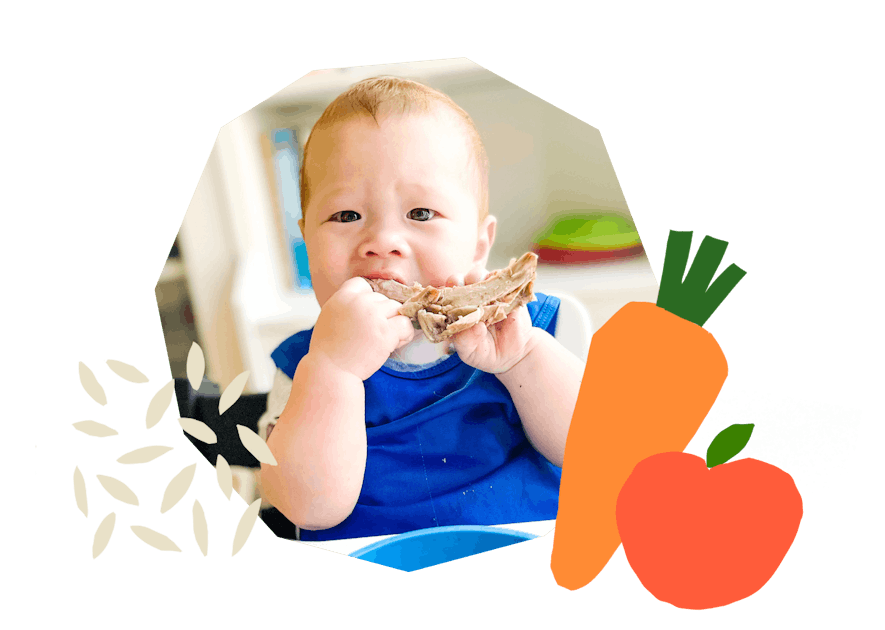
The Program Baby-Led Weaning with Katie Ferraro
A step-by-step digital program for starting solid foods safely and navigating the original 100 FIRST FOODS™ meal plan with baby-led weaning.
 EXPERT-LED, PROVEN APPROACH TO EATING REAL FOOD
EXPERT-LED, PROVEN APPROACH TO EATING REAL FOOD CONCISE VIDEO TRAININGS TO MASTER BABY-LED WEANING
CONCISE VIDEO TRAININGS TO MASTER BABY-LED WEANING 100 FIRST FOODS DAILY MEAL PLAN WITH FOOD PREP VIDEOS
100 FIRST FOODS DAILY MEAL PLAN WITH FOOD PREP VIDEOS
Baby-Led Weaning for Beginners Free Workshop
Is your baby ready to start solid foods, but you’re not sure where to start? Get ready to give your baby a solid foundation to a lifetime of loving real food…even if you’re feeling overwhelmed or confused about this next stage of infant feeding.
Get baby-led weaning recipes and tips delivered to your email inbox.

